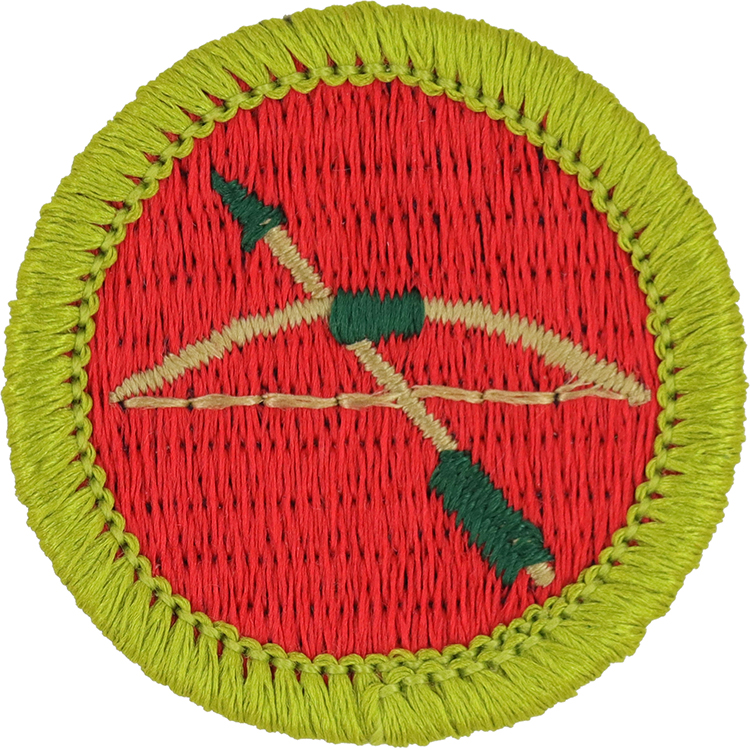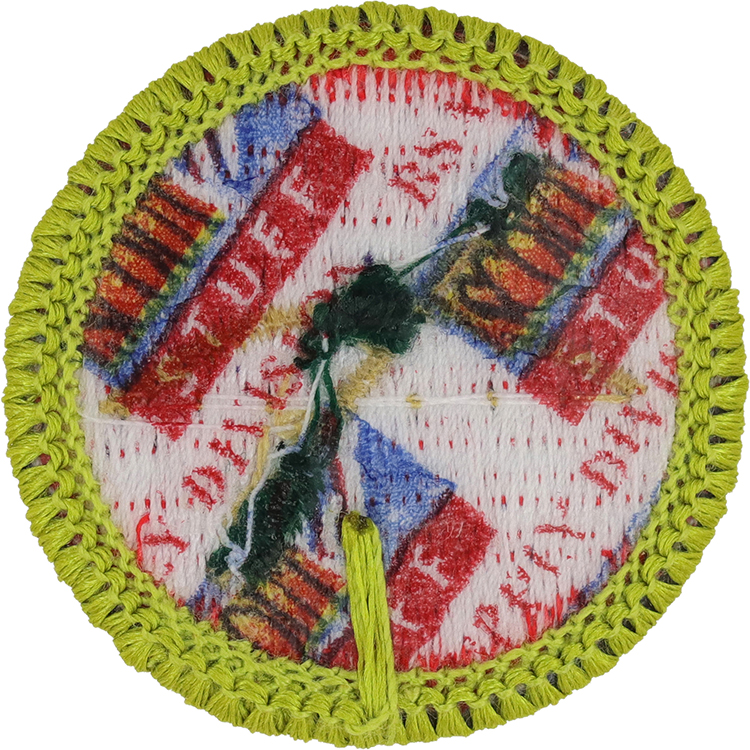
Fig. 1: Archer-J1-Front
- Embroidery: Rayon thread
- Border: Merrowed

Fig. 2: Archer-J1-Reverse
- Back: Scout Stuff imprint
Item Name: Archery 2002 - 2009
Item ID: Archer-J1
Collector Rating: 1
Requirements August 1992 until January 2004
1. Do the following:
(a) Name and explain the archery safety rules.
(b) Tell about the local and state laws on ownership, use, and registration of archery tackle.
2. Do the following:
(a) Name and point out the parts of an arrow.
(b) Name and point out the parts of a bow.
(c) Describe and show how to use an arm guard, shooting glove, finger tab, and quiver.
3. Do the following:
(a) Explain proper care of and how to store the bow, bowstring, arrows, and leather items.
(b) Make a bowstring and use it.
(c) Make one complete arrow from a bare shaft.
(d) Explain the following terms: cast, bow weight, string height (fistmele), aiming, spine, mechanical release, freestyle, and bare bow.
(e) Describe the different types of arrows.
(f) Show the nine basic steps of a good shooting method.
(g) Locate and mark with dental floss, crimp on, or other method the nocking point on a bow string.
4. Shoot with bow and arrows, using a finger release:
(a) One round from any of the following NFAA field rounds and indoor rounds:
(1) A field round of 14 targets and make a score of 60 points
(2) An indoor round and make a score of 50 points
(3) A 900 round and make a score of 225 points*
(4) An indoor FITA round I and make a score of 80 points+
OR
(b) As a member of the NAA Junior Olympic Archery Development Club, qualify as a Yeoman, Junior Bowman, and Bowman.
OR
(c) As a member of the NFAA Junior Division, qualify as a Club of Youth by earning 100-score progression Patches.
5. Explain the following:
(a) The difference between field and target archery.
(b) Field round, hunter round, and animal round.
(c) Scout field round.
(d) Indoor field rounds.
(e) 900, junior 900, Easton, and junior Easton rounds.
(f) Indoor FITA rounds I and II.
(g) FITA and junior FITA rounds.
(h) Junior Olympic qualification rounds.
(I) The importance of obedience to a rangemaster or other person in charge of a range.
* Intermediates 15-17 years old.
Requirements January 2004 until January 2009
1. Do the followin:
(a) State and explain the Range Safety Rules:
(1) Three safety rules when on the shooting range
(2) Three safety rules when retrieving arrows
(3) The four range whistle commands and their related verbal commands.
(b) State and explain the general safety rules for archery. Demonstrate how to safely carry arrows in your hands.
(c) Tell about your local and state laws for owing and using archery tackle.
2. Do the following:
(a) Name and point to the parts of an arrow.
(b) Describe three or more different types of arrows.
(c) Name the four principle materials for making arrows shafts.
(d) Make a complete arrow from a bare shaft.
(e) Explain how to properly care for and store arrows.
3. Do the following:
(a) Explain how to properly care for and store tabs, arm guards, shooting gloves, and quivers.
(b) Explain the following terms: cast, draw weight, string height (fistmele), aiming, spine, mechanical release, freestyle, and barebow.
(c) Make a bowstring.
4. Explain the following:
(a) The importance of obedience to a range officer or other person in charge of a range.
(b) The difference between an end and a round
(c) The difference among field, target, and 3-D archery
(d) How the five-color National Archery Association (NAA) or Federation International de Tir a l’Arc (FITA) target is scored.
(e) How the National Field Archery Association (NFAA) black-and-white field targets and blue indoor targets are scored.
(f) The elimination system used in Olympic archery competition.
5. Do ONE of the following options:
Option A – Using a Recurve Bow or Longbow
(a) Name and point to the parts of the recurve on longbow you are shooting.
(b) Explain how to properly care for and store recurve bows and longbows. (c) Show the nine steps of good shooting for the recurve bow or longbow you are shooting.
(d) Demonstrate the proper way to string a recurve bow or longbow.
(e) Locate and mark with dental floss, crimp-on, or other method, the nocking point on the bowstring of the bow that you are missing.
(f) Do ONE of the following:
(1) Using a compound bow and arrows with a finger release, shoot a single round of ONE of the following BSA, NAA, or NFAA rounds:
(a) An NFAA field round of 14 targets and make a score of 60 points
(b) A BSA Scout field round of 14 targets and make a score of 80 points
(c) A FITA/NAA Olympic (outdoor) round and make a score of 80 points
(d) A junior indoor* round and make a score of 180 points
(e) A FITA/NAA indoor* round I and make a score of 80 points
(f) An NFAA indoor* round and make a score of 50 points
OR
(2) Shooting 30 arrows in five-arrow ends at an 80-centimeter (32-inch) five-color target at 10 yards and using the 10 scoring regions, make a score of 150.
OR
(3) As a member of the NAA’s Junior Olypmic Development Program (JOAD), qualify as a Yeoman, Junior Bowman, and Bowman.
OR
(4) As a member of the NFAA’s Junior Division, earn a Club or Youth 100-score Progression Patch
Option B – Using a Compound Bow
(a) Name and point to the parts of the compound bow you are shooting
(b) Explain how to properly care for and store compound bows.
(c) Show the nine steps of good shooting for the compound bow you are shooting
(d) Explain why it is necessary to have the string on a compound bow replaced at an archery shop
(e) Locate and mark with detail floss, crimp-on, or other method, the nocking point on the bowstring of the bow that you are using.
(f) Do ONE of the following:
(1) Using a compound bow and arrows with a finger release, shoot a single round of one of the following BSA, NAA, or NFAA rounds.
(a) An NFAA field round of 14 targets and make a score of 70 points
(b) A BSA Scout field round of 14 targets and make a score of 90 points
(c) A Junior 900 round and make a score of 200 points
(d) A FITA/NAA Olympic (outdoor) round and make a score of 90 points
(e) A FITA/NAA indoor* round 1 and make a score of 90 points
(f) An NFAA indoor* round and make a score of 60 points
OR
(2) Shooting 30 arrows in five-arrow ends at an 80-centimeter (32-inch) five-color target at 10 yards and using the 10 scoring regions, make a score of 170.
OR
(3) As a member of the NAA’s Junior Olympic Development Program (JOAD), quality as a Yeoman, Junior Bowman, and Bowman.
OR
(4) AS a member of the NFAA’s Junior Division, earn a Cub or Youth 100-score Progression Patch.
*The indoor rounds may be shot outdoors if this is more convenient.
Requirements January 2009 until January 2011
1. Do the following:
(a) State and explain the Range Safety Rules:
(1) Three safety rules when on the shooting range
(2) Three safety rules when retrieving arrows
(3) The four range whistle commands used on a range and their related verbal commands.
(b) State and explain the general safety rules for archery. Demonstrate how to safely carry arrows in your hands.
(c) Tell about your local and state laws for owing and using archery tackle.
2. Do the following:
(a) Name and point to the parts of an arrow.
(b) Describe three or more different types of arrows.
(c) Name the four principle materials for making arrows shafts.
(d) Make a complete arrow from a bare shaft.
(e) Explain how to properly care for and store arrows.
3. Do the following:
(a) Explain how to properly care for and store tabs, arm guards, shooting gloves, and quivers.
(b) Explain the following terms: cast, draw weight, string height (fistmele), aiming, spine, mechanical release, freestyle, and barebow.
(c) Make a bowstring.
4. Explain the following:
(a) The importance of obedience to a range officer or other person in charge of a range.
(b) The difference between an end and a round
(c) The difference among field, target, and 3-D archery
(d) How the five-color National Archery Association (NAA) or Federation International de Tir a l’Arc (FITA) target is scored.
(e) How the National Field Archery Association (NFAA) black-and-white field targets and blue indoor targets are scored.
(f) The elimination system used in Olympic archery competition.
5. Do ONE of the following options:
Option A – Using a Recurve Bow or Longbow
(a) Name and point to the parts of the recurve on longbow you are shooting.
(b) Explain how to properly care for and store recurve bows and longbows.
(c) Show the nine steps of good shooting for the recurve bow or longbow you are shooting.
(d) Demonstrate the proper way to string a recurve bow or longbow.
(e) Locate and mark with dental floss, crimp-on, or other method, the nocking point on the bowstring of the bow that you are missing.
(f) Do ONE of the following:
(1) Using a recurve or longbow and arrows with a finger release, shoot a single round of one of the following BSA, NAA, or NFAA rounds:
(a) An NFAA field round of 14 targets and make a score of 60 points
(b) A BSA Scout field round of 14 targets and make a score of 80 points
(c) A Junior 900 round and make a score of 180 points
(d) A FITA/NAA indoor* round I and make a score of 80 points
(e) An NFAA indoor* round and make a score of 50 points
(2) Shooting 30 arrows in five-arrow ends at an 80-centimeter (32-inch) five-color target at 10 yards and using the 10 scoring regions, make a score of 150.
(3) As a member of the NAA’s Junior Olypmic Development Program (JOAD), qualify as a Yeoman, Junior Bowman, and Bowman.
(4) As a member of the NFAA’s Junior Division, earn a Club or Youth 100-score Progression Patch
Option B – Using a Compound Bow
(a) Name and point to the parts of the compound bow you are shooting
(b) Explain how to properly care for and store compound bows.
(c) Show the nine steps of good shooting for the compound bow you are shooting
(d) Explain why it is necessary to have the string on a compound bow replaced at an archery shop
(e) Locate and mark with detail floss, crimp-on, or other method, the nocking point on the bowstring of the bow that you are using.
(f) Do ONE of the following:
(1) Using a compound bow and arrows with a finger release, shoot a single round of one of the following BSA, NAA, or NFAA rounds.
(a) An NFAA field round of 14 targets and make a score of 70 points
(b) A BSA Scout field round of 14 targets and make a score of 90 points
(c) A Junior 900 round and make a score of 200 points
(d) A FITA/NAA indoor* round 1 and make a score of 90 points
(e) An NFAA indoor* round and make a score of 60 points
(2) Shooting 30 arrows in five-arrow ends at an 80-centimeter (32-inch) five-color target at 10 yards and using the 10 scoring regions, make a score of 170.
(3) As a member of the NAA’s Junior Olympic Development Program (JOAD), quality as a Yeoman, Junior Bowman, and Bowman.
(4) AS a member of the NFAA’s Junior Division, earn a Cub or Youth 100-score Progression Patch.
*The indoor rounds may be shot outdoors if this is more convenient.



